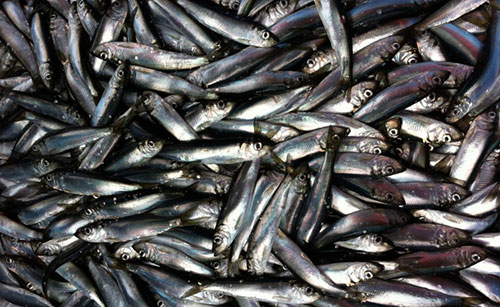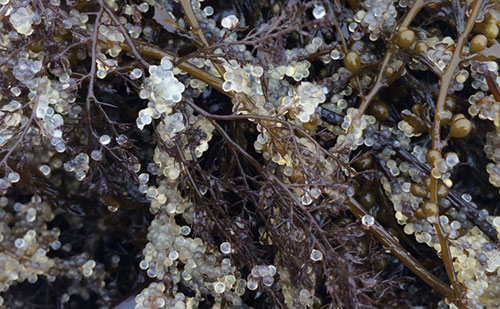
Herring fishery's strength is in the sum of its parts, study finds
February 28, 2016
It's this mindset that resource managers should adopt when considering Pacific herring, one of the most ecologically significant fish in Puget Sound and along the entire West Coast, argue the authors of a paper appearing in the January 2016 print edition of the journal Oecologia. Just like a financial portfolio contains shares from different companies, the diverse subpopulations of herring from different bays and beaches around Puget Sound collectively keep the total population more stable, the study's authors found.
Young adult herring from Puget Sound.
"If you're a manager and you need to invest in multiple pieces of a natural resource, it's helpful to know what the impact will be of diversifying your efforts instead of just focusing on a few spots." Pacific herring swim close to shore to spawn in eelgrass or seaweed, and each subpopulation usually returns to the same area year after year. This life pattern has traditionally created a close relationship between the herring and First Nations peoples and tribes who harvest herring and their eggs on Pacific Northwest beaches, as well as the marine mammals and larger fish that feed on these small, silvery fish. Siple and senior author Tessa Francis, lead ecosystem ecologist with the Puget Sound Institute at UW Tacoma, analyzed 40 years of herring biomass data in Puget Sound to try to understand how the nearly 21 distinct subpopulations behave and relate to each other. They found that each smaller group varied out of synch with the others -- despite sometimes spawning near each other. They also found that high year-to-year variability, which is common in forage fish such as herring, was dampened by the existence of many distinct subpopulations, buffering the wellbeing of the entire Puget Sound herring population from the failures of any single group. "This paper shows that the local variability of herring helps ensure stability of the population," Francis said. "While biologists have recognized local variation in herring anecdotally, not all management has adapted to the 'local matters' perspective yet. This work shows that if you're interested in overall sustainability of the resource, protecting that local diversity is a good strategy." In Puget Sound, the commercial herring fishery is limited and targets juvenile fish in South and Central Puget Sound, mainly caught to be used as bait in sport fisheries, primarily salmon. Concern about overfishing has resulted in relatively light fishing for herring since around the late 1980s, compared with other regions. The Puget Sound herring stock is managed at a relatively fine scale, meaning all of the distinct subpopulations that spawn at various beaches in Puget Sound are known and counted by the Washington Department of Fish and Wildlife.
Puget Sound herring eggs on seaweed.
"Salmon rely heavily on herring as a prey source. We also know that indigenous people connect to herring locally and are using the resource at a very local scale. Herring beaches are in their villages, they're walking distance from their homes," Francis said. This Puget Sound-focused study comes on the heels of a West Coast-wide effort last summer to bring together everyone who has a stake in Pacific herring -- from tribes, First Nations peoples and commercial fishers to fishery managers, nonprofits and scientists. The goal of the three-day summit in British Columbia was to capture the various roles herring plays in the ecosystem and understand how the species fits into the social, economic and ecological landscape. Now, a smaller working group is tasked with creating a way to bring social and cultural knowledge of herring into actual management of the fishery. As a starting point, the first day of the June summit was dedicated to hearing stories of how tribes and First Nations peoples interact closely with the fish. That intimate knowledge is lost to the existing herring management process, Francis said. "These social metrics are currently not used in fisheries management for herring, and yet herring is the forage fish of the people -- they come to shore to spawn and are tightly connected to people," she said. The working group's first paper that discusses the June meeting and initial findings was accepted in the journal Ecosystem Health and Sustainability this month. The team of about 20 people, the second working group of the Ocean Modeling Forum of which Francis is the managing director, will meet three more times, drawing inspiration from communities in Haida Gwaii, British Columbia, and Sitka, Alaska. Ultimately, the group plans to construct a framework that agencies can adopt when they are ready to incorporate human dimensions, such as the cultural significance of fishing, into fisheries management.
Related Paper:
Edited by Mary Kauffman, SitNews
Source of News:
|
||

